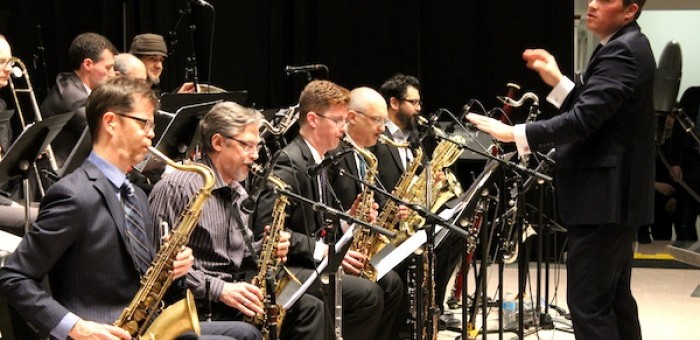Apr 2, 2024 12:59 PM
Saxophonist, Sonic Explorer Casey Benjamin Dies at 45
Casey Benjamin, the alto saxophonist, vocalist, keyboardist and producer who stamped his distinctive sounds on the…

Ryan Truesdell (right) conducts the Gil Evans Project featuring Donny McCaslin (left) during the Elmhurst College Jazz Festival in Elmhurst, Illinois, on Feb. 26.
(Photo: Photo: Brian Zimmerman)For a small city, Elmhurst, Illinois, can accommodate some big jazz talent. That was certainly the case on Feb. 26, when the Chicago suburb played host to composer Ryan Truesdell’s scintillating large ensemble, the Gil Evans Project, as part of the Elmhurst College Jazz Festival.
Celebrating its 49th year, the festival has developed a national reputation for attracting prominent figures in big band jazz and music education—and this year’s program was no exception.
In addition to Truesdell’s group, the lineup featured trumpeter Scott Wendholt (of the Vincent Herring quintet), trombonist Michael Davis (former session player for The Rolling Stones and Bob Dylan) and tenor saxophonist Bob Mintzer, who appeared with his sprightly, groove-oriented big band.
As is its tradition, the festival also boasted numerous clinics and master classes, with participation by roughly 30 university and high school jazz ensembles from locales as distant as California.
The big bands of Millikin University and the University of California, Long Beach set the stage for Truesdell’s performance on Feb. 26, priming the dense crowd at Hammerschmidt Memorial Chapel with dynamic ensemble play and bold, ambitious soloing.
Truesdell, a 35-year-old Wisconsin native, was received warmly by the all-ages audience. In opening remarks, he spoke of his immense pride in the ensemble, whose most recent album, Lines Of Color (Blue Note/ArtistShare), was nominated for a Grammy for Best Large Jazz Ensemble Album.
But Truesdell wasn’t the only Grammy nominee on stage that night. Also among the band’s ranks was trumpeter Michael Rodriguez, whose album Impromptu was nominated for this year’s Best Latin Jazz Album, as well as saxophonist Donny McCaslin, whose solo on “Arbiters Of Evolution” (from Maria Schneider’s Grammy-winning The Thompson Fields album) was nominated for Best Improvised Jazz Solo.
With such talent at his disposal, it’s no wonder that Truesdell has become one of the most noteworthy bandleaders of his era, distinguishing himself as a leading authority on the music of Gil Evans, the legendary Canadian composer and Miles Davis collaborator.
Evans’ (1912–’88) intricate, intellectual arrangements and orchestrations were made famous on such seminal albums as Davis’ Birth of the Cool (1957), Porgy & Bess and Sketches Of Spain (1960), as well as on Evans’ own The Individualism Of Gil Evans (1964).
In his treatment of Evans’ work, Truesdell demonstrates a deep fidelity to his idol’s compositional technique, capturing the late master’s acute sense of nuance and rich chordal palette. But he also brings a fresh perspective to the music, finding vibrant tonal colors and vital rhythmic structures where Evans and other arrangers may have overlooked them. He is, in effect, like a great translator of poetry, altering the raw material of a text in an effort to preserve its essential meaning.
In Elmhurst, Truesdell began with a tasteful arrangement of “Lester Leaps In,” which appeared on Evans’ 1958 masterwork New Bottle Old Wine, and was originally arranged for Cannonball Adderley. Here, it was played as a vivacious swing tune made even feistier by a searing alto saxophone solo by Davie Pietro, one of many combustible soloists on the bandstand that night.
Other feats of individualism included a solo by McCaslin, who played with fierce dynamism on “Time Of The Barracudas,” as well as a feature by Australian trumpeter Mat Jodrell, who delivered a sublime performance on the swaggering “Davenport Blues.” His solo made such an impression on the audience that Truesdell, feigning a grand exit, said, “Well, I don’t know how we can top that! Good night, folks!”
Sitting in on trumpet, guest artist Wendholt was featured in a moving rendition of “Prayer,” the churning ballad from Davis and Evans’ 1959 album Porgy & Bess. The song was part of a four-part Porgy & Bess suite that also swept augustly through “Buzzard Song,” “Gone” and “There’s A Boat Leaving Soon For New York.”
The encore, “Summertime,” was sung with unflustered swing by vocalist Wendy Gilles.
In closing remarks, Truesdell (who has participated in the festival multiple times) referred to Elmhurst as his “home away from home,” and expressed his desire to return next year. When that happens, perhaps the Gil Evans Project will have added even more jazz heroes to its roster. Elmhurst will be sure to make room.

Benjamin possessed a fluid, round sound on the alto saxophone, and he was often most recognizable by the layers of electronic effects that he put onto the instrument.
Apr 2, 2024 12:59 PM
Casey Benjamin, the alto saxophonist, vocalist, keyboardist and producer who stamped his distinctive sounds on the…

“He’s constructing intelligent musical sentences that connect seamlessly, which is the most important part of linear playing,” Charles McPherson said of alto saxophonist Sonny Red.
Feb 27, 2024 1:40 PM
“I might not have felt this way 30 to 40 years ago, but I’ve reached a point where I can hear value in what people…

Albert “Tootie” Heath (1935–2024) followed in the tradition of drummer Kenny Clarke, his idol.
Apr 5, 2024 10:28 AM
Albert “Tootie” Heath, a drummer of impeccable taste and time who was the youngest of three jazz-legend brothers…

“Both of us are quite grounded in the craft, the tradition and the harmonic sense,” Rosenwinkel said of his experience playing with Allen. “Yet I felt we shared something mystical as well.”
Mar 12, 2024 11:42 AM
“There are a few musicians you hear where, as somebody once said, the molecules in the room change. Geri was one of…

Henry Threadgill performs with Zooid at Big Ears in Knoxville, Tennessee.
Apr 9, 2024 11:30 AM
Big Ears, the annual four-day music celebration that first took place in 2009 in Knoxville, Tennessee, could well be…